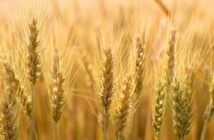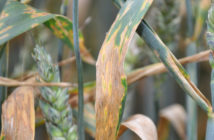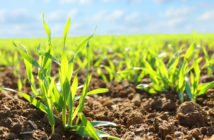Holding back some nitrogen for later in the season could prolong crop greening and boost wheat yields, according to leading agronomy firm Hutchinsons.
Research undertaken as part of the ADAS-run Yield Enhancement Network (YEN) suggests keeping a proportion of nitrogen back until flag leaf emergence (growth stage 39) helps prevent early crop senescence, giving more time for crops to intercept light and build yield, explains trials and research manager Dr Bob Bulmer.
Many growers, apart from those striving for milling specification, tend to have applied all their nitrogen by the second node stage (GS 32) around the end of April, but that can potentially leave crops short of nitrogen after flowering, he says.
“The developing grain has a large demand for nitrogen and protein which will be taken out of the canopy if there is insufficient available, leading to early senescence. Saving a bit of nitrogen for the flag leaf timing, which is usually around 20 May, supports that later demand and extends the growing period from July into August, capturing more light and helping break the yield plateau.
“It’s about using nitrogen more efficiently, not necessarily putting more on, which is something growers in the YEN project are doing very well.”
Mr Bulmer says that splitting nitrogen applications in this way would mean a typical crop receiving 200kg N/ha in total would have around 40kg/ha applied at the end of February/ early March, followed by 80kg/ha at GS 31, 40kg/ha at GS 32 and 40kg/ha at flag leaf emergence.
He favours keeping the final flag leaf dose to around 40kg/ha, even where a larger total dose is being applied on higher yield potential crops. For example, if a total of 220kg N/ha is being applied, he suggests increasing the GS 32 rate to 60kg/ha.
“I’d trim the rates back a bit for backward crops where the yield potential isn’t as high, but the same methodology of splitting doses still applies,” he adds.
Dr Bulmer acknowledges weather around the flag leaf timing can often be dry, which potentially poses a challenge for nitrogen uptake. Liquid nitrogen may offer some benefit over granular forms in such cases, providing growers minimise the risk of crop scorch, he says.
Little and often yields results
Lincolnshire YEN member and previous holder of the UK’s record wheat yield (14.3t/ha) David Hoyles has been using late nitrogen for several years on his 600ha farm east of Spalding.
His “little and often approach” across 150ha of Evolution and Santiago wheat usually involves three or four evenly split granular nitrogen applications through the season, with the first, around 30kg/ha, going on at the end of February and the last at flag leaf emergence.
Given average wheat yields of around 12-13t/ha, total applied nitrogen is a relatively modest 150kg/ha. This is partly due to the success of split applications, but also reflects the productive moisture retentive silt-based soils and a rotation that leaves high levels of residual nitrogen, he says.
“Exact amounts of applied nitrogen vary depending on soil mineral nitrogen testing in February, crop canopy cover and weather, but our general approach is to encourage plant growth as early as possible in the season and keep crops green for as long as we can to maximise light interception and put on yield. We’re fortunate enough to have a small enough area that we can get around with fertiliser in a day, so can afford to more accurately pick the right timing.”
Mr Hoyles acknowledges that prolonged greening can push harvest later than some growers may like, but insists the system works for his business.
“We have a lot of spring cropping in the form of potatoes, sugar beet, vining peas and beetroot and don’t grow any oilseed rape, so there isn’t the pressure to get crops cleared as quickly in August. If harvest runs into late August or even early September it isn’t so much of an issue for us – we’d rather have the extra yield put on during that period.”
As part of the YEN project, Mr Hoyles is investigating higher nitrogen rates to see if yields can be pushed further. Small 4ha plots with different rates (200kg, 280kg and 360kg N/ha) have been established and the same split application approach will be taken as on the rest of the farm.
“We’re aiming for a 15t/ha crop and are interested to see whether higher nitrogen will make a difference. The challenge will be to keep the crop standing,” he notes.



